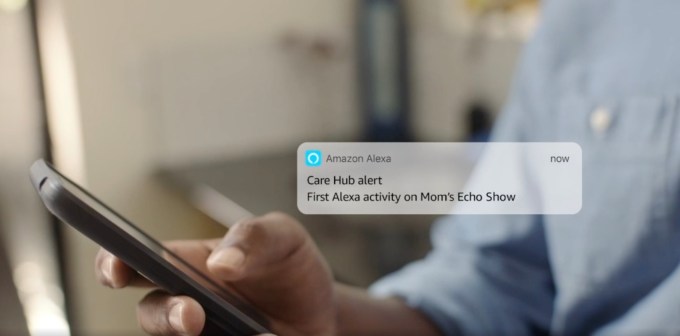Amazon today announced a set of new features aimed at making its Alexa devices more useful to aging adults. With the launch of “Care Hub,” an added option in the Alexa mobile app, family members can keep an eye on older parents and loved ones, with their permission, in order to receive general information about their activities and to be alerted if the loved one has called out for help.
The idea behind Care Hub, the company explains, is to offer reassurance to family members concerned about an elderly member’s well-being, while also allowing those family members to maintain some independence.
This is not a novel use case for Alexa devices. Already, the devices are being used in senior living centers and other care facilities, by way of third-party providers.
Amazon stresses that while family members will be able to keep an eye on their loved ones’ Alexa use, it will respect their privacy by not offering specific information. For example, while a family member may be able to see that their parent had played music, it won’t say what song was played. Insted, all activity is displayed by category.
In addition, users will be able to configure alerts if there’s no activity or when the first interaction with the device occurs on a daily basis.
And if the loved one calls for help, the family member designated as the emergency contact can drop in on them through the Care Hub or contact emergency services.

Image Credits: Amazon
These new features are double-opt in, meaning that both the family member and their loved one need to first establish a connection between their Alexa accounts through an invitation process. This is begun through the new Care Hub feature in the Alexa app, then confirmed via text message or email.
That may seem like a reasonable amount of privacy protection, but in reality, many older adults either struggle with or tend to avoid technology. Even things seemingly simple — like using a smartphone, email or texting — can sometimes be a challenge.
That means there are scenarios where a family member could set up the Care Hub system by accessing the other person’s accounts without their knowledge or by inventing an email that becomes “the parent’s email” just for this purpose.
Alternately, they could just mislead mom or dad by saying they are helping them set up the new Alexa device, and — oh, can I borrow your phone to confirm something for the setup? (Or some other such deception.)
A more appropriate option to protect user privacy would be to have Alexa periodically ask the loved one if they were still okay with the Care Hub monitoring option being enabled, and to alert the loved one via the Alexa mobile app that a monitoring option was still turned on.
Of course, there may certainly be older adults who appreciate the ability to be connected to family in this way, especially if they are located at a distance from their family or are feeling isolated due to the coronavirus pandemic and social distancing requirements that’s keeping family members from being able to visit.
Amazon says Care Hub is rolling out in the U.S. The company notes it will learn from customer feedback to expand the feature set over time.

